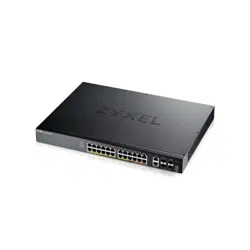Loading ...
Loading ...
Loading ...

Chapter 13 Neighbor
XGS2220 Series User’s Guide
137
The following table describes the fields in the above screen.
Table 39 MONITOR > Neighbor > Neighbor Details
LABEL DESCRIPTION
Search Ports... Enter the port number to search and display the ports you specified. The result will display
in the below list.
You can enter multiple ports separated by comma (“,”) or hyphen (“-”) for a range. For
example, enter “3-5” for ports 3, 4, and 5. Enter “3,5,7” for ports 3, 5, and 7.
In Stacking mode, the first number represents the slot and the second the port number.
Enter “1/1-1/24,2/23” for ports 1 to 24 for the Switch in slot 1 and port 23 for the Switch in
slot 2, for example.
SLOT This field appears only in Stacking mode. Click the drop-down list to choose the slot
number of the Switch in a stack.
Port This shows the port of the Switch, on which the neighboring device is discovered.
Desc. This shows the port description of the Switch.
PD Health For PoE models.
This shows the status of auto PD recovery on this port.
• Red: The Switch failed to get information from the PD connected to the port using
LLDP, or the connected PD did not respond to the Switch’s ping requests.
• Yellow: The Switch is restarting the connected PD by turning the power off and
turning it on again.
• Green: The Switch successfully discovered the connected PD using LLDP or ping.
• –: Auto PD Recovery is not enabled on the Switch and the port, or the Switch does
not supply power to the connected PD.
Link Speed This shows the speed (either 10M for 10 Mbps, 100M for 100 Mbps, 1G for 1 Gbps, 2.5G for
2.5 Gbps, 5G for 5 Gbps, or 10G for 10 Gbps) and the duplex (F for full duplex or H for
half). This field displays Down if the port is not connected to any device.
PoE Draw (W) For PoE models.
This shows the consumption that the neighboring device connected to this port draws
from the Switch. This allows you to plan and use within the power budget of the Switch.
Reset Click this button to turn OFF the power of the neighbor device and turn it back ON again.
A count down button (from 5 to 0) starts.
Note: The Switch must support power sourcing (PSE) or the network device is a
powered device (PD).
Remote
System Name This shows the system name of the neighbor device.
Port Bridge This shows the neighboring device’s MAC address or the port number connected to the
Switch.
Model This shows the model name of the neighbor device. This field will show “–” for devices that
do not support the ZON utility.
MAC This shows the MAC address of the neighbor device.
Firmware This shows the firmware version of the neighbor device. This field will show “–” for devices
that do not support the ZON utility.
Location This shows the geographic location of the neighbor device. This field will show “–” for
devices that do not support the ZON utility.
Desc. This shows the description of the neighbor device’s port which is connected to the
Switch.
IPv4 This shows the IPv4 address of the neighbor device. The IPv4 address is a hyper link that
you can click to log into and manage the neighbor device through its Web Configurator.
Loading ...
Loading ...
Loading ...
